
August 1, 2013, by Zoë Goodwin
News from the week in brief
Very brief
This week at The University of Nottingham, physicists and neuroscientists have unlocked one of the mysteries of the human brain thanks to a new brain research tool. The hidden treasures of one of Nottinghamshire’s oldest country estates are to be uncovered. A Nottingham vet student has used horses from the Household Cavalry Mounted Regiment to investigate lameness. A major new technology has been developed which enables all of the world’s crops to take nitrogen from the air. A BREEAM Outstanding rating has been awarded to Nottingham’s Energy Technologies building. Stuart Senior of Gleeds presented a cheque for £25,000 to the University to help more young people reach their academic potential. PRESCOS Ltd, a spin-out company from The University of Nottingham has been acquired by American bioscience business, Crown Bioscience, Inc. And finally, the University has secured a prestigious Green Flag Award for Jubilee Campus.
Brief
 Physicists and neuroscientists from the University of Nottingham and University of Birmingham have together enabled scientists to map a kind of brain function that up to now could not be studied, allowing a more accurate exploration of how both healthy and diseased brains work. By using both functional Magnetic Resonance Imaging (fMRI) and electroencephalography (EEG), scientists can now show that the post-stimulus signal also actually reflects changes in brain signalling.
Physicists and neuroscientists from the University of Nottingham and University of Birmingham have together enabled scientists to map a kind of brain function that up to now could not be studied, allowing a more accurate exploration of how both healthy and diseased brains work. By using both functional Magnetic Resonance Imaging (fMRI) and electroencephalography (EEG), scientists can now show that the post-stimulus signal also actually reflects changes in brain signalling.
To read more about their results, click here.
Computer scientists and art historians will use the latest mobile technologies to offer visitors new ways to reveal the cultural, industrial and historical heritage of t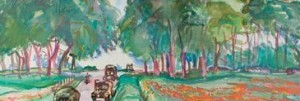 he Thoresby Estate. Wander Thoresby, a collaboration between the University and the Stonebridge Trust which manages Thoresby’s parkland, centres on the artwork of Countess Manves who repeatedly painted favourite scenes and views of the Estate. Some of the early watercolours, otherwise too delicate to go on public display will be accessible to the public through high-quality digital copies of the Countess’ largely unexplored works.
he Thoresby Estate. Wander Thoresby, a collaboration between the University and the Stonebridge Trust which manages Thoresby’s parkland, centres on the artwork of Countess Manves who repeatedly painted favourite scenes and views of the Estate. Some of the early watercolours, otherwise too delicate to go on public display will be accessible to the public through high-quality digital copies of the Countess’ largely unexplored works.
To learn more about the Wander Thoresby project, click here.
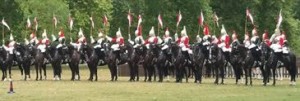 Jessica Putnam, a third year student from the School of Veterinary Medicine and Science has spent 13 months documenting incidents of lameness amongst the 294 horses belonging to the British Army’s Household Cavalry mounted Regiment (HCMR). Her research which has just been published in Equine Veterinary Journal found that the most common cause of lameness was cellulitis, a bacterial infection of the connective tissue of the skin.
Jessica Putnam, a third year student from the School of Veterinary Medicine and Science has spent 13 months documenting incidents of lameness amongst the 294 horses belonging to the British Army’s Household Cavalry mounted Regiment (HCMR). Her research which has just been published in Equine Veterinary Journal found that the most common cause of lameness was cellulitis, a bacterial infection of the connective tissue of the skin.
Jessica’s supervisor Dr Sarah Freeman explains more about what lameness is and why the HCMR horses were used. To read what she said, click here.
Professor Edward Cocking, Director of The University of Nottingham’s Centre for Crop Nitrogen Fixation has developed a major new technology which enables 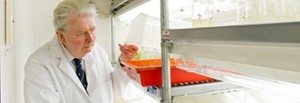 all of the world’s crops to take nitrogen from the air rather than expensive and environmentally damaging fertilisers. The implications of this research are enormous as this new technology has the potential to help feed more people in many of the poorer parts of the world, while at the same time, dramatically reducing the amount of synthetic nitrogen produced in the world.
all of the world’s crops to take nitrogen from the air rather than expensive and environmentally damaging fertilisers. The implications of this research are enormous as this new technology has the potential to help feed more people in many of the poorer parts of the world, while at the same time, dramatically reducing the amount of synthetic nitrogen produced in the world.
To learn more about the science behind the technology, click here.
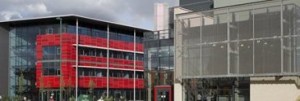 The Energy Technologies Building based at the University’s Innovation Park has been awarded A BREEAM Outstanding rating – making it the first laboratory in England to achieve this. The BRE Environmental Assessment Method is the world’s leading design and assessment method for sustainable buildings. The Energy Technologies Building is an exemplar low carbon building and dedicated to the research and development of sustainable energy technologies.
The Energy Technologies Building based at the University’s Innovation Park has been awarded A BREEAM Outstanding rating – making it the first laboratory in England to achieve this. The BRE Environmental Assessment Method is the world’s leading design and assessment method for sustainable buildings. The Energy Technologies Building is an exemplar low carbon building and dedicated to the research and development of sustainable energy technologies.
To hear what Chris Jagger, Chief Estates and Facilities Officer said about this honour, click here.
Stuart Senior of Gleeds has presented a cheque for £25,000 to go towards Nottingham Potential. The money was raised at a black tie dinner hosted by consultancy firm Gleeds at which five-time gold medallist, Sir Steve Redgrave was guest of honour. The money will help disadvantaged young people to reach their academic potential through a variety of programmes.
To read more about Nottingham Potential, click here.
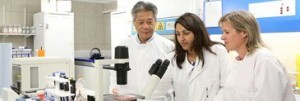 PRESCO Ltd, a pre-clinical research and development service which focuses on oncology has been acquired by American bioscience business, Crown Bioscience, Inc. PRESCO Ltd, a spin-out company from The University of Nottingham provided unique patient relevant and predictive cancer models to over 30 national and international biotech and pharmaceutical companies. Neil Rotherham, Chairman of PRECOS Ltd added: “The acquisition of PRECOS by Crown Bioscience will allow us to grow the business as part of a larger organisation. Our innovative models and expertise perfectly complement Crown Bioscience’s robust panel of models and services’.
PRESCO Ltd, a pre-clinical research and development service which focuses on oncology has been acquired by American bioscience business, Crown Bioscience, Inc. PRESCO Ltd, a spin-out company from The University of Nottingham provided unique patient relevant and predictive cancer models to over 30 national and international biotech and pharmaceutical companies. Neil Rotherham, Chairman of PRECOS Ltd added: “The acquisition of PRECOS by Crown Bioscience will allow us to grow the business as part of a larger organisation. Our innovative models and expertise perfectly complement Crown Bioscience’s robust panel of models and services’.
To read how this company was originally established, click here.
Jubilee campus has won a prestigious Green Flag Award for its impressive outdoor space and sustainable credentials. Jubilee Campus covers 65 acres of land wit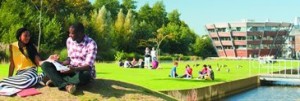 h many lakes which, as well as being home to a variety of wildlife, provide storm water for attenuation and cooling for the campus’ buildings. Flowering meadows have been created alongside all new buildings since 2007. Nottingham was the first university to be awarded a Green Flag in 2003 for University Park.
h many lakes which, as well as being home to a variety of wildlife, provide storm water for attenuation and cooling for the campus’ buildings. Flowering meadows have been created alongside all new buildings since 2007. Nottingham was the first university to be awarded a Green Flag in 2003 for University Park.
To hear from Chris Jagger, Chief Estates and Facilities Officer about its strong sustainable credentials, click here.

Wow ! Thanks for sharing the updates mate ! The science and technology updates will surely please a lot of people ..
-Pramod